|
|
Constantinus
Africanus, Benedictine monk of Monte Cassino, |
|
|
Constantinus
Africanus, Benedictine monk of Monte Cassino, |
1. COMPASSION for the SICK: The Rule of St. Benedict
2. MEDIEVAL MEDICAL PRACTICE: 2.1 Medieval Surgery and Medicine; 2.2 Lateran II; 2.3. Lateran IV.
3. COUNCILS and PENITENTIALS on ABORTION: 3.1. Introd.; 3.2. Ancara; 3.3. Caesarius; 3.4. Visigoths; 3.5. Penit. of Theodore
4. AQUINAS on LIFE and ANIMATION: 4.1. Beginning of Life; 3.2. Double Effect; 3.3. End of Life.
5. DEBATES on ANIMATION: 5.1. Introduction; 5.2. Obstetrical and Unintended Abortion.
1.
COMPASSION
for the SICK
WITH the collapse of the Roman Empire in the West, health care and the practice of medicine became increasingly associated with monasteries. The Rule of St. Benedict particularly emphasizes the care of the sick; and hospitality, including medical care, was freely offered to travellers and guests. The modern term “hospital” reflects the “hospitality” offered to the medieval hospes, the guest or traveller.
|
|
St. Benedict. Medieval Austrian Fresco |
from THE RULE of BENEDICT
|
Mar 15; July
15; Nov 14 |
(RM 70:3) |
|
CHAPTER
36: THE
SICK
BROTHERS |
XXXVI
DE
INFIRMIS FRATRIBUS |
|
CARE of the sick must rank before and above everything, so that they may truly be served as Christ Himself, 2 for He said: I was sick and you visited me (Matt 25:36) 3 and, What you did for one of these who are least, you did for me (Matt 25:40). 4 But let the sick are themselves to consider that they are served out of honor for God, and they are not to sadden their brothers who serve them with superfluous demands; 5 Yet they are to be patiently borne with, because from such as these a more abundant reward is acquired. 6 The abbot shall therefore exercise the greatest care that they not suffer any neglect. |
1 Infirmorum cura ante omnia et super omnia adhibenda est, ut sicut revera Christo ita eis serviatur, 2 quia ipse dixit: Infirmus fui et visitastis me, 3 et: Quod fecistis uni de his minimis mihi fecistis. 4 Sed et ipsi infirmi considerent in honorem Dei sibi servire, et non superfluitate sua contristent fratres suos servientes sibi; 5 qui tamen patienter portandi sunt, quia de talibus copiosior merces acquiritur. 6 Ergo cura maxima sit abbati ne aliquam neglegentiam patiantur. |
|
These brothers who are sick are to be assigned a
separate
room and a God-fearing attendant who is also diligent and solicitous. 8
Baths may be offered the sick whenever this is helpful, but those who are
healthy, especially the young are to be allowed this less frequently. 9
Additionally, the sick who are very weak may be allowed to eat meat to
recover their strength; but when they are better, all are to abstain from
meat as usual. |
7 Quibus fratribus infirmis sit cella super se deputata et servitor timens Deum et diligens ac sollicitus. 8 Balnearum usus infirmis quotiens expedit offeratur ‑ sanis autem et maxime iuvenibus tardius concedatur. 9 Sed et carnium esus infirmis omnino debilibus pro reparatione concedatur; at, ubi meliorati fuerunt, a carnibus more solito omnes abstineant. |
|
10 Moreover the abbot is to maintain the greatest care that that the sick are not neglected by the cellarers or attendants. For he is responsible for whatever is lacking in his disciples. |
10
Curam autem maximam habeat abbas ne a cellarariis aut a servitoribus
neglegantur infirmi. Et ipsum respicit quicquid a discipulis delinquitur. |
2.
MEDIEVAL
MEDICAL
PRACTICE
|
|
Uroscopy,
The Articella. |
AT the Second and Fourth Lateran Councils the hierarchy of the Western Church expressed concern and disapproval over the large number of clergy and members of religious orders who were undertaking the practice of medicine. The bishops’ and pope’s concerns seem to have been twofold: first, the secular practice of charging a fee for caring for the sick seemed incompatible with the compassion and charity expected of priests and religious. Second, medieval surgery was brutal: it entailed agonizing pain for the patient and the deliberate (and sometimes copious) “shedding of blood” by the clerical medical-practitioner. The notion of clergy being involved in acts - whether judicial or medical - that directly caused agony or shed blood was deemed incompatible with the clerical and vowed state. Thus as the Middle Ages progressed, health care become more and more the exclusive province of secular physicians trained in newly-founded medical faculties of the burgeoning universities in Paris, Oxford, Cambridge, and - especially in the case of medicine - Salerno in Italy.
|
Bodleian Library, Oxford MS. Ashmole 1462 Miscellaneous medical and herbal texts, in Latin England, late 12th century |
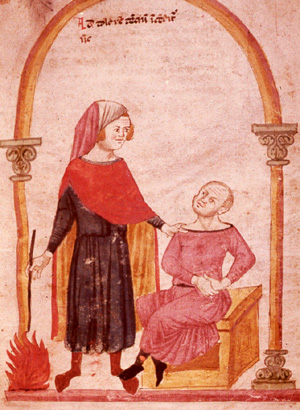 |
|
2.1.1 |
Physician reassures patient: prepares for cautery |
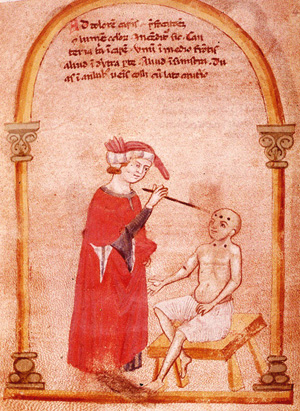 |
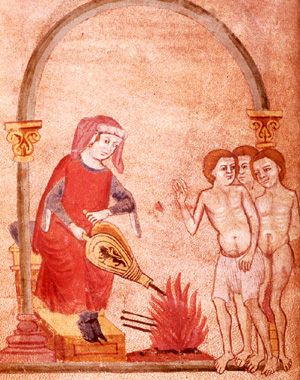 |
| 2.1.2. Cautery for headache | Patients prepare for cautery |
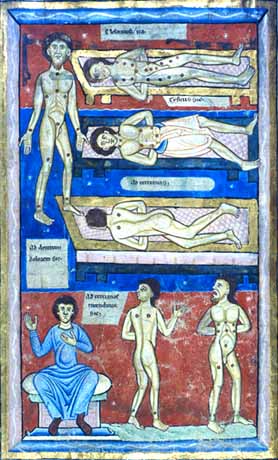 |
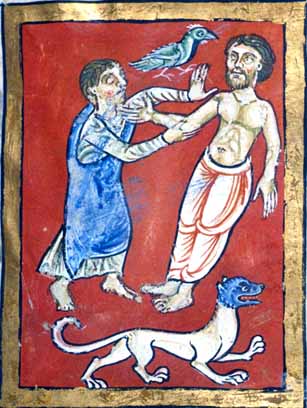 |
| 2.1.3. Cautery points 9v | Man Bitten by Rabid Dog 16r |
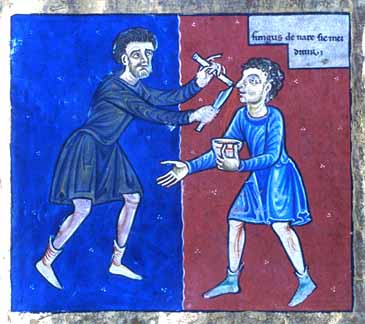 |
2.1.4. |
 |
Cataract Surgery |
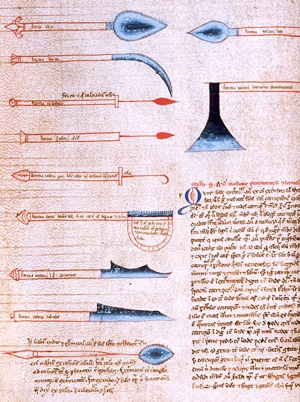 |
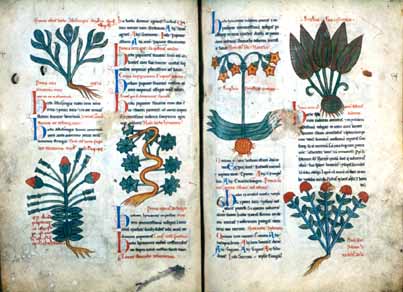 |
| 2.1.5. Surgical Instruments | Herbal Remedies 28v-29r |
 |
| 2.1.6. Obstetrical Instruments |
|
|
|
|
|
|
|
2.2.
THE
SECOND
LATERAN
Pope Innocent III Dreams of St. Francis |
|
|
|
|
|
|
|
|
|
|
|
[THE
GENERAL
and ECUMENICAL
COUNCIL
of the CATHOLIC
CHURCH
|
Concilia oecumenica et generalia Ecclesiae catholicae - Concilium Lateranense a. II 113 |
|
|
|
|
|
|
|
|
|
|
CANON 9. |
|
|
|
|
|
|
|
| Moreover, the evil and detestable practice has grown, so we understand, whereby monks and canons regular, after receiving the habit and making their profession, are learning [1] civil law and [2] medicine with a view to temporal gain, in scornful disregard of the rules of their blessed teachers Benedict and Augustine. | Prava autem consuetudo prout accepimus et detestabilis inolevit quoniam monachi et regulares canonici post susceptum habitum et professionem factam spreta beatorum magistrorum Benedicti et Augustini regula leges temporales et medicinam gratia lucri temporalis addiscunt. |
|
[1] Inappropriate Practice of Civil Law |
|
| In fact, burning with the fire of avarice, they make themselves the advocates of suits; and since they have to neglect the psalmody and hymns, placing their trust in the power of fine rhetoric instead, they confuse what is right and what is wrong, justice and iniquity, by reason of the variety of their arguments. But the imperial constitutions testify that it is truly absurd and reprehensible for clerics to want to be experts in the disputes of law courts. We decree by apostolic authority that lawbreakers of this kind are to be severely punished. | Avaritiae namque flammis accensi se patronos causarum faciunt. Et cum psalmodiae et hymnis vacare debeant gloriosae vocis confisi munimine allegationum suarum varietate iustum et iniustum fas nefas que confundunt. Attestantur vero imperiales constitutiones absurdum immo et opprobrium esse clericis si peritos se velint disceptationum esse forensium. Huiusmodi temeratores graviter feriendos apostolica auctoritate decernimus. |
|
[2] Inappropriate Practice of Medicine |
|
| There are also those who, neglecting the care of souls, completely ignore their state in life, promise health in return for hateful money and make themselves healers of human bodies. And since an immodest eye manifests an immodest heart, religion ought to have nothing to do with those things of which virtue is ashamed to speak. | Ipsi quoque neglecta animarum cura ordinis sui propositum nullatenus attendentes pro detestanda pecunia sanitatem pollicentes humanorum curatores se faciunt corporum. Cum que impudicus oculus impudici cordis sit nuntius illa de quibus loqui erubescit honestas non debet religio pertractare. |
|
Therefore, we forbid by apostolic authority this practice to continue, so that the monastic order and the order of canons may be preserved without stain in a state of life pleasing to God, in accord with their holy purpose. Furthermore, bishops, abbots and priors who consent to and fail to correct such an outrageous practice are to be deprived of their own honours and kept from the thresholds of the church. |
Ut ergo ordo monasticus et canonicus deo placens in sancto proposito inviolabiliter conservetur ne hoc ulterius praesumatur apostolica auctoritate interdicimus. Episcopi autem abbates et priores tantae enormitati consentientes et non corrigentes propriis honoribus spolientur et ab ecclesiae liminibus arceantur. |
|
|
|
|
|
|
|
2.3.
THE
FOURTH
LATERAN |
|
|
|
|
|
|
|
|
|
|
|
|
|
|
CANON 18. |
|
|
|
|
|
|
|
|
No cleric may pronounce a sentence of death, or execute such a sentence, or be present at its execution. If anyone in consequence of this prohibition (hujusmodi occasions statuti) should presume to inflict damage on churches or injury on ecclesiastical persons, let him be restrained by ecclesiastical censure. Nor may any cleric write or dictate letters destined for the execution of such a sentence. Wherefore, in the chanceries of the princes let this matter be committed to laymen and not to clerics. Neither may a cleric act as judge in the case of the Rotarrii, archers, or other men of this kind devoted to the shedding of blood. No subdeacon, deacon, or priest shall practice that part of surgery involving cauterization or cutting. Neither shall anyone in judicial tests or ordeals by hot or cold water or hot iron bestow any blessing; the earlier prohibitions in regard to dueling remain in force. |
Sententiam sanguinis nullus clericus dictet aut proferat sed nec sanguinis vindictam exerceat aut ubi exercetur intersit. Si quis autem huiusmodi occasione statuti ecclesiis vel personis ecclesiasticis aliquod praesumpserit inferre dispendium per censuram ecclesiasticam compescatur nec quisquam clericus literas scribat aut dictet pro vindicta sanguinis destinandas unde in curiis principum haec solicitudo non clericis sed laicis committatur. Nullus quoque clericus rottariis aut balistariis aut huiusmodi viris sanguinum praeponatur nec illam chirurgiae artem subdiaconus diaconus vel sacerdos exerceant quae ad ustionem vel incisionem inducit nec quisquam purgationi aquae ferventis vel frigidae seu ferri candentis ritum cuiuslibet benedictionis aut consecrationis impendat salvis nihilominus prohibitionibus de monomachiis sive duellis antea promulgatis. |
|
|
|
|
|
|
|
3.
COUNCILS,
BISHOPS,
and PENITENTIALS
|
|
|
|
|
|
|
|
INTRODUCTION:
(adapted from Jones,
Soul of the Embryo, ch 5, pp. 67-69
A LATER tradition represented by the Irish canons (late seventh century), the Bigotian Penitential (early eighth century) and the Old Irish Penitential (early ninth century) -made a distinction between penances depending on the age of the foetus. For example, the Old Irish Penitential gave three and a half years penance for abortion after the pregnancy had become established, but seven years if the flesh had formed and fourteen years if the soul had entered. Thus this tradition, in marked contrast to Basil [whose canons insist that there should be no distinction based on the stage of pregnancy], related penance directly to the stage of the embryo. It was also remarkable in reflecting not a two-stage but a three-stage process[:]
In the first stage due embryo was unformed ‘like water’;
in the second stage the flesh was formed but had no soul;
in the third stage the foetus gained a soul.
This threefold pattern is not found in Aristotle or the Septuagint, but something like it can be found in Hippocrates and there are parallels in the Talmud and in the Koran. It may simply reflect the re-emergence of the distinction between formation and quickening (the mother’s sense of inner movement). If this interpretation is correct then, for these writers, abortion was not true homicide if done before the first signs of movement of the child in the womb. Nevertheless, early abortion was still regarded as a serious sin and required three and a half years’ arduous penance.
The first Anglo-Saxon penitentials were written in the late seventh century and associated with Theodore, Archbishop of Canterbury. These also made a distinction depending on the age of the embryo: before 40 days the penance was one year; after 40 days it was the same as the penance for homicide - three years.
What gradually emerged in the Middle Ages was a two-tier system in which most sins were dealt with by private penance while a limited number of specified sins attracted public canonical penalties.
The development of canon law in the West from the eleventh century onwards looked not to the penitentials but to collections of early canons and to the Fathers of the Church. Opinions were taken from the letters, sermons and treatises of authorities such as Augustine, Jerome and Ambrose. On this basis there were three possible positions that could be held with respect to abortion:
[1] abortion was homicide whatever the stage of pregnancy
[2] abortion was homicide only after formation/ensoulment
[3] contraception was homicide as was abortion whatever the stage of pregnancy.
|
|
|
|
|
|
|
|
|
|
|
|
|
3.2.
THE
COUNCIL of
ANCARA |
|
|
|
|
|
|
|
|
Concerning women who commit fornication, and destroy what they have conceived |
DE 280 MULIERIBUS, QUAE FORNICATAE PARTUS 281 SUOS NECANT |
| CANON 21. Concerning women who commit fornication, and destroy what they have conceived, or who compound drugs to cause abortion: an ancient decree excluded them from the Church until the end of their lives. However, in a spirit of greater leniency we decree that they must complete ten years of penance. | XXI 282 De mulieribus, quae fornicantur et partus suos necant, sed et de his 283, quae agunt secum, ut utero 284 conceptos 285 excutiant, antiqua quidem definitio usque ad exitum vitae 286 eas ab ecclesia 287 removet 288. Humanius 289 autem nunc definimus, ut eis decem annorum tempus poenitentiae tribuatur. |
|
|
|
|
|
|
|
|
|
|
|
|
|
3.3.
CÆSARIUS
of
ARLES |
|
|
|
|
|
|
|
|
SERMON
44.2.
(abortion & contraception) ed. G. Morin, Caesarii Arelatensis Opera I, 1, CCSL 103 (Turnhout, 1953), p. 196. |
Caesarius Arelatensis. Sermones 44.2 |
|
No woman should [ever] take drugs to induce abortion, nor kill children she has conceived or borne. If anyone does this, she should know that before Christ's tribunal she will have to plead her case before those she has killed. Moreover, women should not take diabolical potions for the purpose of becoming unable to conceive children. A woman who does this must realize that she will be guilty of as many homicides as the number of children she might have borne |
Nulla mulier potiones ad avorsum accipiat, nec filios aut conceptos aut iam natos occidat; quia, quaecumque hoc fecerit, ante tribunal Christi sciat se causam cum illis quos occiderit esse dicturam. Sed nec illas diabolicas potiones mulieres debent accipere, per quas iam non possint concipere. Mulier quaecumque hoc fecerit, quantoscumque parere potuerat, tantorum homicidiorum se ream esse cognoscat. |
|
|
|
|
|
|
|
|
|
|
|
|
|
3.4.
THE
VISIGOTHIC
LAWS |
|
|
|
|
|
|
|
|
Tr. based on: Amundsen, Visigothic Medical Legislation', pp. 568-69. |
Zeumer, Leges Visigothorum |
|
VI.3.2.
Old law. If a free man causes a free woman to abort. |
VI.3.2.
Antigua. Si ingenuus ingenuam abortare fecerit. |
| If anyone strikes a pregnant woman by any blow whatever or through any circumstance causes a free woman to abort, and from this she dies, let him be punished for homicide. If, however, only the fetus is destroyed, and the woman is in no way debilitated, and a free man is recognized as having inflicted this to a free woman, if he has destroyed a formed infant, let him pay 150 solidi; if it is truly an unformed [infant], let him pay 100 solidi in restitution for the deed. | Si quis mulierem gravidam percusserit quocumque hictu aut per aliquam orrnsionem mulierem ingenuam abortare fecerit, et exinde mortua fuerit, pro homicidio puniatur. Si autem tantumodo partus excutiatur, et mulier in nullo debilitata fuerit, et ingenuus ingenue hoc intulisse cognoscitur, si firmatum infantem extincxit, CL solidos reddat; si vero infirmem, C solidos pro facto restituat.' |
|
VI.3.7. King Chindasvind. Concerning those who kill their own children, either already having been born or in utero. |
VI.3.7.
Flavius Chindasvindus Rex.
De his, qui filios suos aut natos aut in utero necant. |
| There is nothing worse than the depravity of those who, disregarding piety, become murderers of their own children. In as much as it is said that the crime of these has grown to such a degree throughout the provinces of our land that men as well as women are found to be the performers of this heinous action, we therefore, forbidding this dissoluteness, decree that, if a free woman or a female slave murders a son or a daughter which has been born, or, while having it still in utero, either takes a potion to induce abortion, or by any other means whatsoever presumes to destroy her own fetus, after the judge of the province or of the territory learns of such a deed, let him not only sentence the performer of this crime to public execution, or if he wishes to preserve her life, let him not hesitate to destroy the vision of her eyes, but also, if it is evident that the woman's husband ordered or permitted such things, let him not be reluctant to subject the same to a similar punishment. |
Nihil est eorum pravitate deterius, qui, pietatis inmemores, filiorum suorum necatores existunt. Quorum quia vitium per provincias regni nostri sic inolevisse narratur, ut tam viri quam femine sceleris huius auctores esse repperiantur, ideo hanc licentiam proibentes decernimus, ut, seu libera seu ancilla natum filium filiamve necaverit, sive adhuc in utero habens, aut potionem ad avorsum acceperit, aut alio quocumque modo extinguere partum suum presumserit, mox provincie index aut territorii talem facturn reppererit, non solum operatricem criminis huius publica morte condemnet, aut si vite reservare voluerit, omnem visionem oculorum eius non moretur extinguere, sed etiam si maritum eius talia iussisse vel permisisse patuerit, eundem etiam vindicte simili subdere non recuset.2
|
|
|
|
|
|
|
|
|
|
|
|
|
|
3.5.
THE
PENITENTIAL
of |
|
|
|
|
|
|
|
| Leniency: Age of gestation, poverty |
24. Women who commit abortion before [the fetus] has life, shall do penance for one year or for the three forty-day periods or for forty days, according to the nature of the offense; and if later, that is, more than forty days after conception, they shall do penance as murderesses, that is for three years on Wednesdays and Fridays and in the three forty-day periods. This according to the canons is judged [punishable by] ten years.
25. If a mother slays her child, if she commits homicide, she shall do penance for fifteen years, and never change except on Sunday.
26. If a poor woman slays her child, she shall do penance for seven years. In the canon it is said that if it is a case of homicide, she shall do penance for ten years.
27. A woman who conceives and slays her child in the womb within forty days shall do penance for one year; but if later than forty days, she shall do penance as a murderess.
|
|
|
|
|
|
|
4.
AQUINAS on
LIFE, St. Thomas Aquinas |
|
|
|
|
|
|
|
4.1
INTRODUCTION:
(adapted from Jones,
Soul of the Embryo, ch 8, pp. 119-123
IN the Middle Ages, the question of the moment of ensoulment was shaped by another important force: the rediscovery of Aristotle’s works and their introduction into the new university culture of the thirteenth century. In this context a potent new synthesis was developed between the (Christianized) philosophy of Aristotle and Latin theology. The most prominent architect of this synthesis was the theologian and philosopher Thomas Aquinas. Basing his account on that of Aristotle, Thomas argued that
[1] there was a succession of souls in the embryo: that it was first merely vegetative (nutritiva), then animal (sensitiva) then human (intellectiva). As the culmination of the process of development, the intellectual soul is given last. [...]
[2] According to this view, the embryo is truly alive and its activities of growth and nutrition are expressions of this life.
[3] However, the life the embryo has initially is not specifically human life [...] Thomas interpreted Aristotle as claiming that the intellectual soul comes ‘from outside’, when formation is complete, which is at 40 days for males and 90 for females (Commentary on the Sentences III, D.3, Q.5, art. 2, citing Aristotle History of Animals 7.3, 583b 3-5, 15-23).
The claim that the soul was created specially by God (not generated by the parents) and that this occurred after the embryo had been fully formed was the common teaching of the medieval scholastic theologians.
|
|
|
|
|
|
|
5.
DEBATES
on the SIGNIFICANCE |
|
|
|
|
|
|
|
5.1 INTRODUCTION:
(adapted from Jones, Soul of the Embryo, ch. 5, pp. 68-71
MEDIEVAL canon lawyers were [...] faced with an apparent contradiction. Some canons implied that the destruction of an unformed embryo was actual homicide (Decretals V, tit. 12, can. 5), but others implied that the destruction of an unformed embryo was not actual homicide (Decretals V, tit. 12, can. 20). One way to resolve this contradiction was to say that the killing of an unformed embryo was not homicide in the strict and technical sense, but that it was ethically equivalent of homicide, and could be treated as homicide for some legal purposes. [...] Many authors took abortion of an embryo prior to formation and ensoulment to be just as serious a sin as abortion of an ensouled embryo. Those, such as Thomas Aquinas, who explicitly thought that contraception and early abortion were less serious sins than homicide, held that they were second only to homicide, ‘after the sin of murder, whereby a human nature already in actual existence is destroyed, this sort of sin seems to hold the second place, whereby the generation of human nature is precluded’ (Sum.Cont.Gent. III, Q. 122; see also Com.Sent. IV, D. 31, Q. 4). What was common to all the writers of this period was their classification of abortion of the early human embryo as mortal sin and as something at least analogous to homicide: intentional, moral or spiritual homicide.
The universal condemnation of the practice of abortion during this period was reflected in the imposition of excommunication for abortion by local synods in Riez (1234), Lille (1288), Avignon (1326) and Lavaur (1368) (see Connery 1977, p. 148). Excommunication had once been part of the discipline of penance (for penance was at first defined by time away from communion), but as reconciliation began to anticipate the completion of penance, excommunication ceased to be a normal element in the sacrament. It was reintroduced as part of the two-tier system of church discipline to emerge in the Middle Ages.
5.2.
OBSTETRICAL
and
UNINTENDED
ABORTION
(adapted from Jones, Soul of the Embryo, ch. 12, pp. 178-183
THE first Christians followed the Jewish ethical principle that ‘we do not set aside one life for another’ (Talmud, Mishnahh Oholot 7.6). However, they faced a difficulty in accepting that ‘her life takes precedence over its life, for they saw the life of the unborn child as equally inviolable. The practical question of what to do in a situation in which a woman’s life was threatened by her pregnancy was therefore extremely problematic for Christians. It is not altogether surprising that in the first thousand years of the Church’s history, theologians preferred to pass over this difficulty in silence and to speak of abortion in circumstances where they were clear that it was sinful. It was not until the late Middle Ages that Christian theologians begin to address directly the question of abortion to save the mother’s life.
5.2.1. [St.] Antoninus of Florence (1389-1459)
ONE of the first to discuss this case was [St.] Antoninus of Florence (1389-1459). He declared that it was neither legitimate to kill the woman to save the child (by Caesarean section) nor to kill the infant to save the woman (by abortion). If the only way to save someone is by killing someone else, it is better to do nothing.
However, he made one exception to this rule. Citing fellow Dominican John of Naples, he argued that before the soul was infused into the embryo (which, following Thomas Aquinas, he regarded as occurring at 40 days for males and 80 days for females) it was legitimate to abort the embryo to save the mother’s life. This was not homicide, strictly speaking. However, an act that destroyed the early embryo and so prevented a child from coming to be was very close to homicide, therefore it could only be justified to save the mother’s life. Furthermore, if it were doubtful whether or not the embryo possessed a human soul then it was not to be harmed. Antoninus only permitted abortion of the pre-ensouled embryo to save the mother’s life. Nevertheless, it was very significant in explicitly allowing an exception to the traditional prohibition. Antoninus had great authority and was followed by several theologians such as Sylvester Prierias (d.1523) and Martin Aspilcueta (1493-1586), more commonly known as Doctor Navarrus.
5.2.2. Antonius of Cordoba (1485-1578)
EARLY in the sixteenth century a Franciscan theologian called Antonius of Cordoba (1485-1578) proposed a different distinction for understanding the ethics of abortion. He saw no ethical distinction between killing an embryo before or after ensoulment. Both acts were forms of homicide.
However, he saw an important difference between
[a] treatments which directly aimed at causing the death of the unborn infant (de se mortifera)and
[b] medicines that were directly intended to help the woman but which had a possible side-effect of causing an abortion (de se salutifera).
[a] The former included taking poison, cutting up the embryo in the womb or hitting the woman to cause a miscarriage. These were forbidden.
[b] The latter included treatments such as bleeding, baths and purgatives. These were legitimate.
A woman had a duty to care for her child but she had a prior right (ius potius) to look after her own health. Nevertheless, this right would not justify a direct attack on the child who was an innocent and not an unjust aggressor.
5.2.3. Peter of Navarre (d. 1594)
PETER of Navarre (d. 1594) accepted this new distinction and gave the analogy of a pregnant woman fleeing from a wild bull. It was legitimate for her to run and leap to escape, even if this caused a miscarriage. The miscarriage is not her aim here, or even the means to an end, but is a tragic side-effect. It might be foreseen but it is not directly willed or intended. Peter also introduced another distinction. If the ensouled infant was capable of being born alive and baptized then he thought the woman should not take medicine that might cause a miscarriage, even where this would otherwise be legitimate. In his view, the spiritual welfare of the child was more important than the physical welfare of the woman. Baptizing a child, even if it died soon after birth, had great significance because of the received opinion that a child who died unbaptized could not enter heaven. This theme would recur in the tradition but it is important not to overstate its significance.
5.2.4. Gabriel Vasquez (1551-1604)
THE Jesuit theologian Gabriel Vasquez (1551-1604) followed Antonius of Cordoba in permitting medicina sanative that might indirectly cause abortion. However, he disagreed with Peter of Navarre about the requirement to forgo medical treatment because of the spiritual needs of the infant. The woman has no obligation to sacrifice her life for someone else’s spiritual benefit. She might choose to do so, but she has no duty to do so.
This Webpage was created for a workshop held at Saint Andrew's Abbey, Valyermo, California in 2002